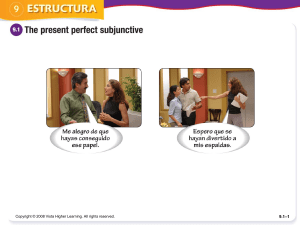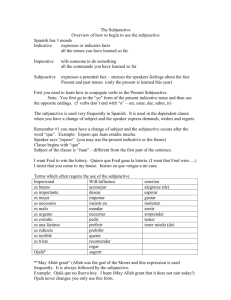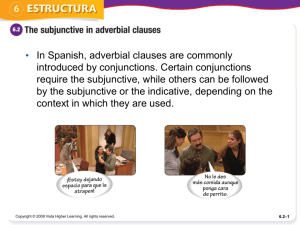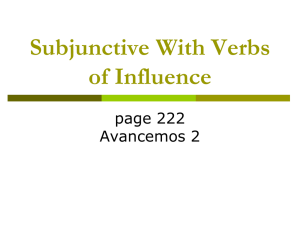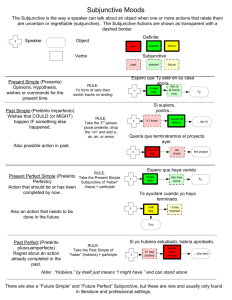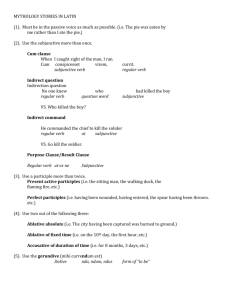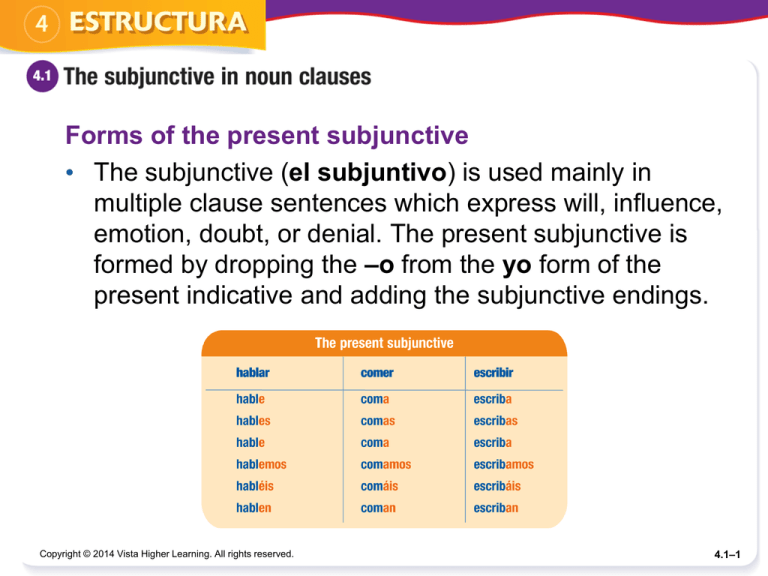
Forms of the present subjunctive
• The subjunctive (el subjuntivo) is used mainly in
multiple clause sentences which express will, influence,
emotion, doubt, or denial. The present subjunctive is
formed by dropping the –o from the yo form of the
present indicative and adding the subjunctive endings.
Copyright © 2014 Vista Higher Learning. All rights reserved.
4.1–1
The indicative is used to express actions, states, or facts the
speaker considers to be certain. The subjunctive expresses the
speaker’s attitude toward events, as well as actions or states that
the speaker views as uncertain.
Copyright © 2014 Vista Higher Learning. All rights reserved.
4.1–2
• Verbs with irregular yo forms show that same
irregularity throughout the forms of the present
subjunctive.
Copyright © 2014 Vista Higher Learning. All rights reserved.
4.1–3
• Verbs that have stem changes in the present
indicative have the same changes in the present
subjunctive. Remember that only –ir verbs
undergo stem changes in the nosotros/as and
vosotros/as forms.
Copyright © 2014 Vista Higher Learning. All rights reserved.
4.1–4
• The following five verbs are irregular in the
present subjunctive.
Copyright © 2014 Vista Higher Learning. All rights reserved.
4.1–5
Verbs that end in –car, –gar, and –zar undergo spelling changes in
the present subjunctive.
sacar: saque
jugar: juegue
almorzar: almuerce
The present subjunctive form of hay is haya.
No creo que haya una solución.
I don’t think there is a solution.
Copyright © 2014 Vista Higher Learning. All rights reserved.
4.1–6
Verbs of will and influence
• A clause is a group of words that contains both a
conjugated verb and a subject (expressed or implied). In
a subordinate (dependent) noun clause (oración
subordinada sustantiva), a group of words function
together as a noun.
Copyright © 2014 Vista Higher Learning. All rights reserved.
4.1–7
• When the subject of the main clause of a sentence
exerts influence or will on the subject of the subordinate
clause, the verb in the subordinate clause must be in
the subjunctive.
MAIN CLAUSE
CONNECTOR
SUBORDINATE CLAUSE
Yo quiero
que
tú vayas al médico.
Copyright © 2014 Vista Higher Learning. All rights reserved.
4.1–8
Necesito que consigas estas
pastillas en la farmacia.
I need you to get these pills at the
pharmacy.
El médico siempre me recomienda
que deje de fumar.
The doctor always recommends that I
quit smoking.
Insisto en que vayas a la sala de
emergencias.
I insist that you go to the emergency
room.
Se oponen a que salgas si estás
enfermo.
They object to your going out if you’re
sick.
Copyright © 2014 Vista Higher Learning. All rights reserved.
4.1–9
Pedir is used with the subjunctive to ask someone to do
something.
Preguntar is used to ask questions, and is not followed by the
subjunctive.
Copyright © 2014 Vista Higher Learning. All rights reserved.
4.1–10
• The infinitive, not the subjunctive, is used with
verbs and expressions of will and influence if
there is no change of subject in the sentence.
Quiero ir a Bogotá en junio.
Prefiero que vayas en agosto.
I want to go to Bogota in June.
I prefer that you go in August.
Copyright © 2014 Vista Higher Learning. All rights reserved.
4.1–11
Verbs of emotion
• When the main clause expresses an emotion
like hope, fear, joy, pity, or surprise, the verb in
the subordinate clause must be in the
subjunctive if its subject is different from that of
the main clause.
Espero que te recuperes pronto.
Qué pena que necesites una
operación.
I hope you recover quickly.
What a shame you need an
operation.
Copyright © 2014 Vista Higher Learning. All rights reserved.
4.1–12
Copyright © 2014 Vista Higher Learning. All rights reserved.
4.1–13
The subjunctive is also used with expressions of emotion that begin
with ¡Qué…! (What a…!/It’s so…!)
¡Qué pena que él no vaya!
What a shame he’s not going!
The expression ojalá (I hope; I wish) is always followed by the
subjunctive. The use of que with ojalá is optional.
Ojalá (que) no llueva.
I hope it doesn’t rain.
Ojalá (que) no te enfermes.
I hope you don’t get sick.
Copyright © 2014 Vista Higher Learning. All rights reserved.
4.1–14
• The infinitive, not the subjunctive, is used with
verbs and expressions of emotion if there is no
change of subject in the sentence.
No me gusta llegar tarde.
Es mejor que lo hagas ahora.
I don’t like to be late.
It’s better that you do it now.
Copyright © 2014 Vista Higher Learning. All rights reserved.
4.1–15
Verbs of doubt or denial
• When the main clause implies doubt,
uncertainty, or denial, the verb in the
subordinate clause must be in the
subjunctive if its subject is different from that
of the main clause.
No cree que él nos quiera
engañar.
Dudan que eso sea un buen
tratamiento.
She doesn’t believe that he
wants to deceive us.
They doubt that would be a
good treatment.
Copyright © 2014 Vista Higher Learning. All rights reserved.
4.1–16
Copyright © 2014 Vista Higher Learning. All rights reserved.
4.1–17
• The infinitive, not the subjunctive, is used with
verbs and expressions of doubt or denial if there
is no change in the subject of the sentence.
Es imposible viajar hoy.
Es improbable que él viaje hoy.
It’s impossible to travel
today.
It’s unlikely that he would travel
today.
Copyright © 2014 Vista Higher Learning. All rights reserved.
4.1–18
The subjunctive is also used after quizá(s) and tal vez (maybe;
perhaps) when they signal uncertainty, even if there is no change
of subject in the sentence.
Quizás vengan a la fiesta.
Maybe they’ll come to the party.
Copyright © 2014 Vista Higher Learning. All rights reserved.
4.1–19

